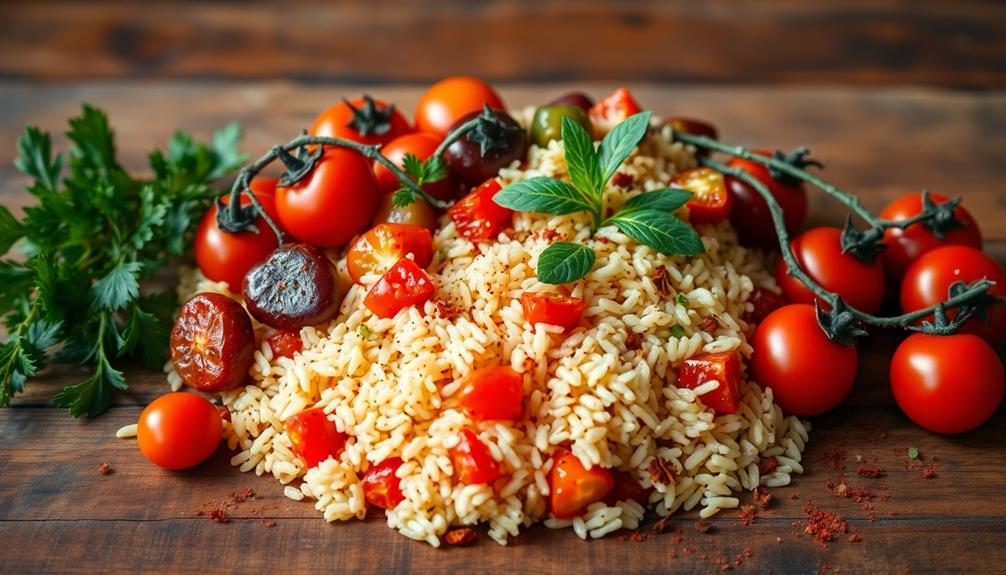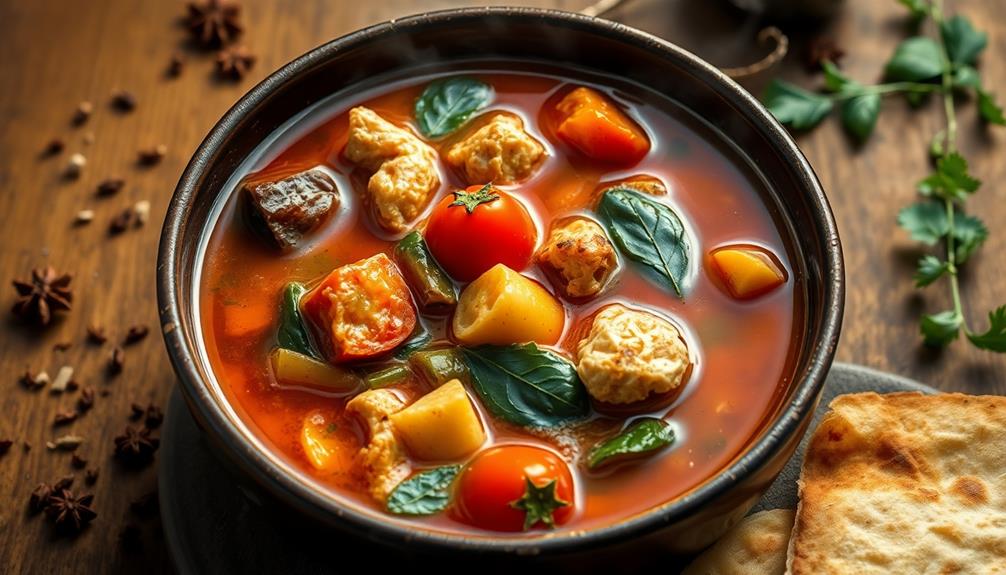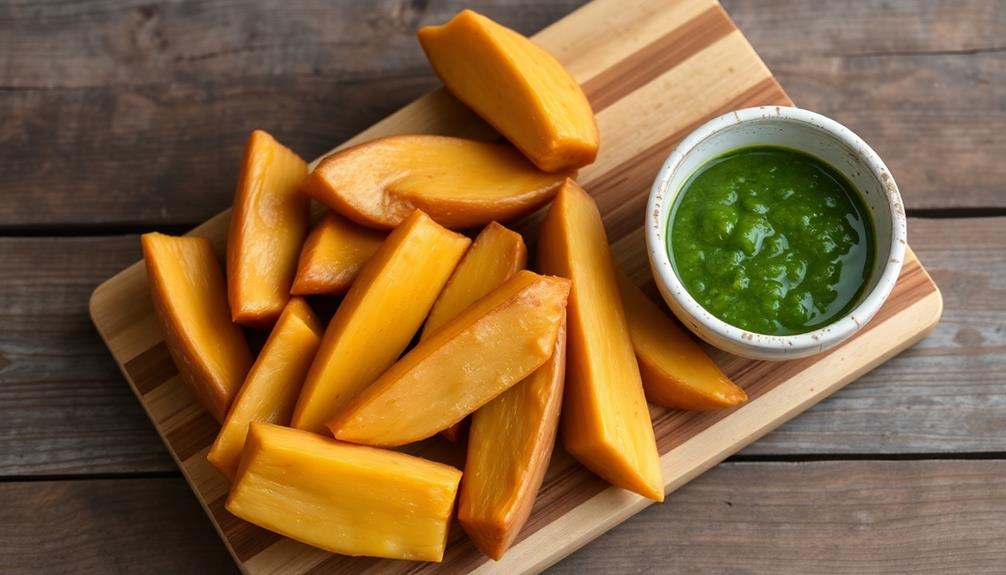Hold on – you're about to discover the iconic West African dish that sparks friendly debates across the globe! Jollof rice is a beloved staple, tracing its roots to the Senegambia region and spreading throughout West Africa. This comforting and complex dish features long-grain rice simmered with tomatoes, onions, and spices – and each country and family has their own special twist! The secret lies in the balance of flavors and the slow cooking method. Whether you prefer the smoky Ghanaian version or the sweeter Nigerian take, one thing's for sure: Jollof rice brings communities together through shared meals and cultural pride. And there's so much more to explore!
Key Takeaways
- Jollof rice is a celebrated West African dish with origins traced to the Senegambia region, developed by the Wolof people and now widely enjoyed across the region.
- Jollof rice is a unifying dish that brings communities together, representing cultural pride and culinary diversity, and sparking friendly debates on the "one true" recipe.
- The key to exceptional Jollof rice lies in the blend of spices, tomatoes, and slow cooking, resulting in comforting and complex flavors with depth.
- Jollof rice is gaining popularity outside of West Africa, especially in diaspora communities, with restaurants worldwide featuring it on their menus.
- Cooking and sharing Jollof rice creates lasting memories, evoking nostalgia and cultural pride, and strengthening relationships through shared meals and festive occasions.
History

Where does the origins of jollof rice, the iconic West African dish, lie? Well, the roots of this delicious meal can be traced back hundreds of years to the Senegambia region, where the Wolof people first developed the recipe.
Over time, the dish spread throughout West Africa, becoming a beloved staple in countries like Nigeria, Ghana, and Sierra Leone.
What makes jollof rice so special? It's the perfect blend of long-grain rice, tomatoes, onions, and a mouthwatering array of spices that come together to create a vibrant, flavorful dish.
The cooking process, which involves simmering the ingredients in a single pot, is key to developing the dish's signature taste.
Today, jollof rice remains a centerpiece of many West African celebrations and gatherings, bringing families and communities together through the shared love of this iconic meal.
Recipe
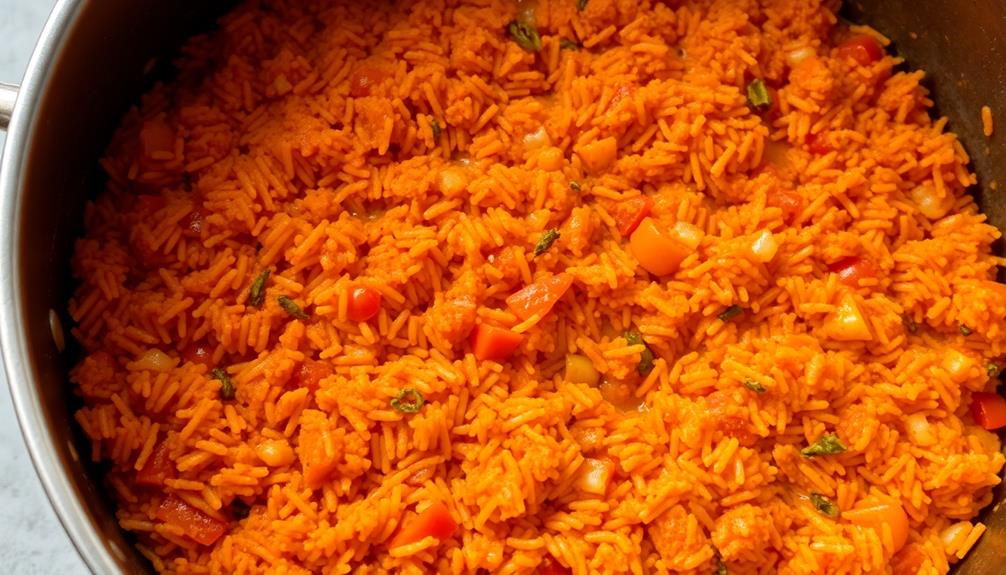
Jollof rice is a beloved West African dish that has captivated palates worldwide. This vibrant, flavorful rice dish is a staple in many households across the region, with each country and even family having their own unique spin on the recipe. At its core, Jollof is a celebration of the rich, diverse culinary traditions of West Africa.
The key to a truly exceptional Jollof lies in the harmonious blend of spices, tomatoes, and a long, slow cooking process that allows the flavors to meld and develop. The result is a dish that's both comforting and complex, with a depth of flavor that will leave you craving more.
Ingredients:
- 2 cups long-grain white rice
- 1 large onion, diced
- 3 cloves garlic, minced
- 2 medium tomatoes, diced
- 1 red bell pepper, diced
- 2 tablespoons tomato paste
- 1 teaspoon thyme
- 1 teaspoon curry powder
- 1 teaspoon paprika
- 1 teaspoon salt
- 1/4 teaspoon cayenne pepper
- 2 cups chicken or vegetable broth
- 2 tablespoons vegetable oil
Cooking Instructions:
In a large pot, heat the vegetable oil over medium heat. Add the diced onion and sauté until translucent, about 5 minutes. Add the minced garlic and sauté for an additional minute.
Stir in the diced tomatoes, bell pepper, tomato paste, thyme, curry powder, paprika, salt, and cayenne pepper. Cook the mixture for about 10 minutes, stirring occasionally, until it thickens into a flavorful sauce.
Add the rice and broth to the pot, stirring to combine. Bring the mixture to a boil, then reduce the heat to low, cover, and simmer for 25-30 minutes, or until the rice is tender and has absorbed all the liquid. Remove from heat and let sit, covered, for an additional 10 minutes.
Tips:
For an extra layer of flavor, consider adding smoked paprika or a teaspoon of ground ginger to the spice blend. Additionally, feel free to experiment with different protein options, such as chicken, shrimp, or even tofu, to create a more substantial meal.
Cooking Steps

Alright, let's get cooking!
First, you'll want to rinse that rice thoroughly to remove any excess starch.
Next, sauté some onions and tomatoes until they're nice and fragrant.
Then, add the rice and stock, and let it simmer until the rice is tender.
Step 1. Rinse Rice Thoroughly Before Cooking

Before you begin cooking the Jollof rice, it's crucial to thoroughly rinse the rice. This simple step removes any impurities or excess starch that could make the dish sticky or gritty.
Simply place the rice in a fine-mesh strainer and run it under cool, clean water, gently stirring the grains with your hand. Keep rinsing until the water runs clear – this ensures the rice will cook up light and fluffy.
Next, transfer the rinsed rice to a bowl and let it sit for a few minutes to drain completely. This extra step helps the rice cook more evenly, resulting in a perfectly textured Jollof that's sure to impress your family and friends.
With the rice prepped and ready, you're one step closer to enjoying this iconic West African dish in all its flavorful glory. Get excited, because the best part is yet to come!
Step 2. Sauté Onions and Tomatoes
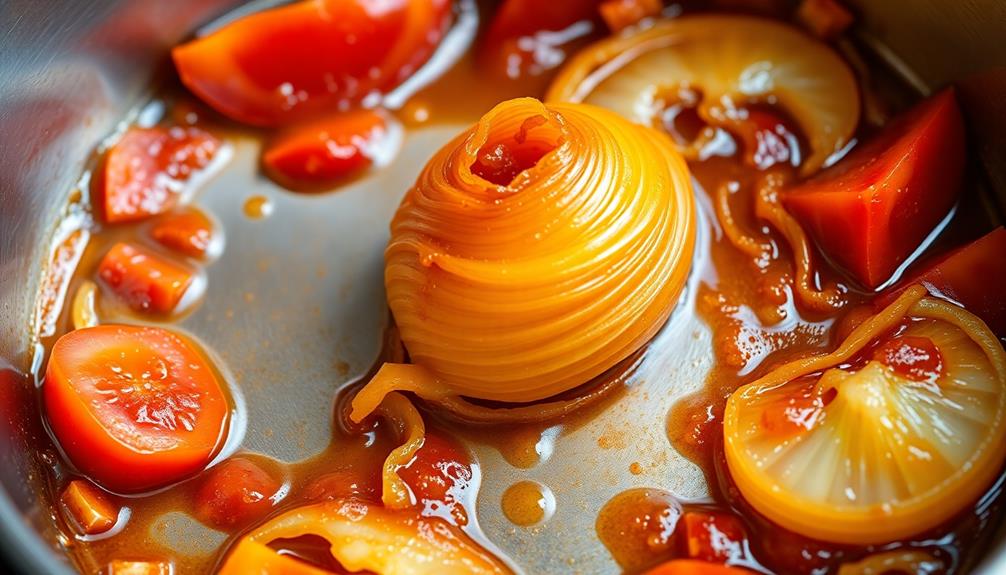
Next, you'll want to sauté the onions and tomatoes.
Heat a large skillet or pot over medium heat and add a splash of oil. Once the oil is hot, toss in the diced onions. Let them sizzle and soften for a few minutes, stirring occasionally.
Now, add the chopped tomatoes to the pan. The tomatoes will release their juices, creating a delicious base for your jollof rice.
Sauté the onions and tomatoes together for about 5-7 minutes, until they're nicely softened and the flavors have melded.
Be sure to stir the mixture frequently to prevent any burning. You want the onions to be translucent and the tomatoes to break down into a tasty sauce.
Once they're ready, you can move on to the next step of adding your spices and rice. Get ready for the mouthwatering aromas to fill your kitchen!
Step 3. Add Rice and Stock
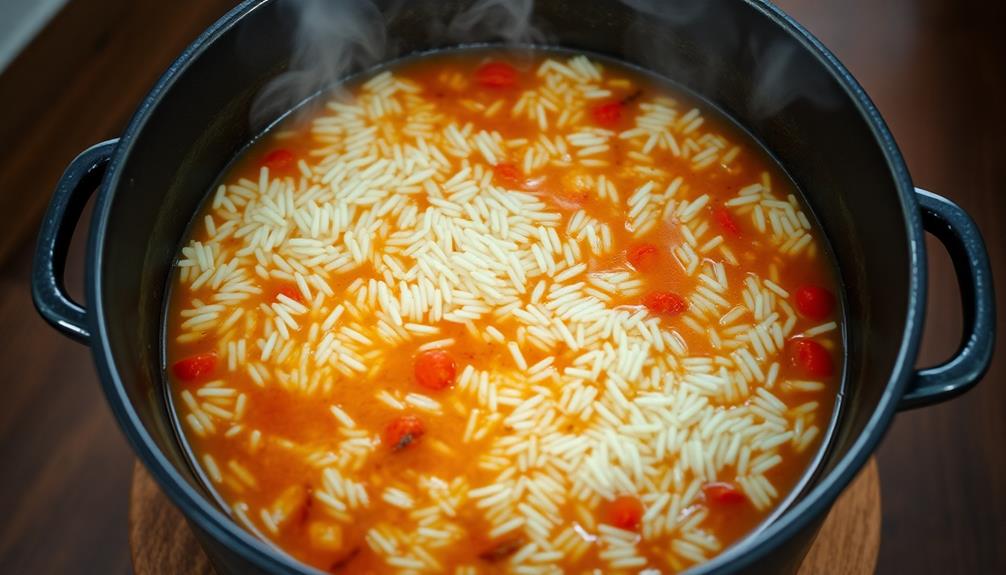
With the aromatic onion and tomato base ready, it's time to add the rice and stock. Grab your long-grain white rice and give it a good rinse until the water runs clear. This will help remove any excess starch, ensuring your Jollof rice turns out fluffy and separate.
Next, pour in the flavorful stock – whether it's chicken, beef, or vegetable. The stock will infuse the rice with even more delicious taste. Bring the mixture to a boil, then reduce the heat, cover, and let it simmer gently.
As the rice cooks, the grains will slowly absorb all the wonderful juices, transforming into a vibrant, fragrant dish. Keep an eye on it, stirring occasionally, until the rice is tender and the liquid has been fully absorbed.
With the base and rice prepared, you're well on your way to creating an authentic and mouthwatering Jollof feast!
Step 4. Simmer Until Rice Is Tender

Once the rice and stock are combined, it's time to let them simmer until the rice is tender. This is the key to achieving that classic Jallof flavor!
Keep the heat at a gentle simmer, allowing the rice to slowly absorb all the delicious juices. Remember, patience is a virtue – it may take about 25-30 minutes for the rice to become perfectly soft and fluffy.
As the Jallof simmers, you'll notice the kitchen filling with the most tantalizing aromas. The blend of onions, garlic, and spices will have your taste buds tingling in anticipation.
Stir the pot occasionally to ensure even cooking. You'll know the rice is ready when it's no longer crunchy, but soft and yielding to the bite.
Once the rice is tender, you're ready to move on to the next step. Get ready to add some color and texture to your Jallof dish!
Step 5. Fluff With Thyme and Bay Leaves
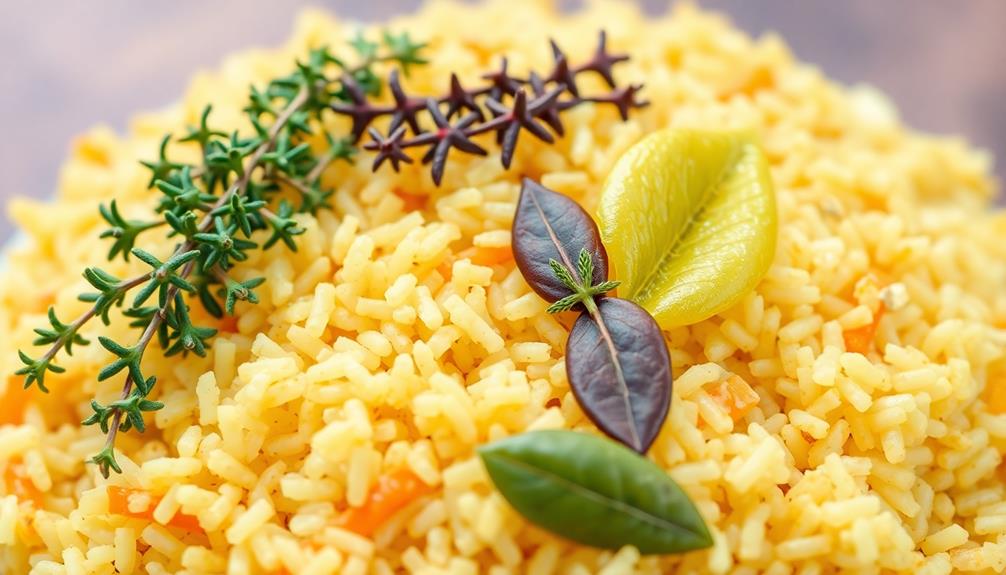
To fluff your Jallof, gently stir in a few sprigs of fresh thyme and a couple of bay leaves. The aromatic herbs will infuse the rice with an irresistible fragrance, elevating the dish to new heights.
As the rice cooks, the thyme and bay leaves will release their flavors, adding a wonderful complexity to the Jallof.
Be sure to stir the mixture occasionally, allowing the herbs to mingle with the rice and infuse it with their essence.
Once the rice is tender and fluffy, remove the thyme and bay leaves. The Jallof will now be bursting with flavor, ready to be served and enjoyed by all.
The combination of the savory rice, the fragrant herbs, and the tantalizing aroma will create a truly mouthwatering experience.
Final Thoughts
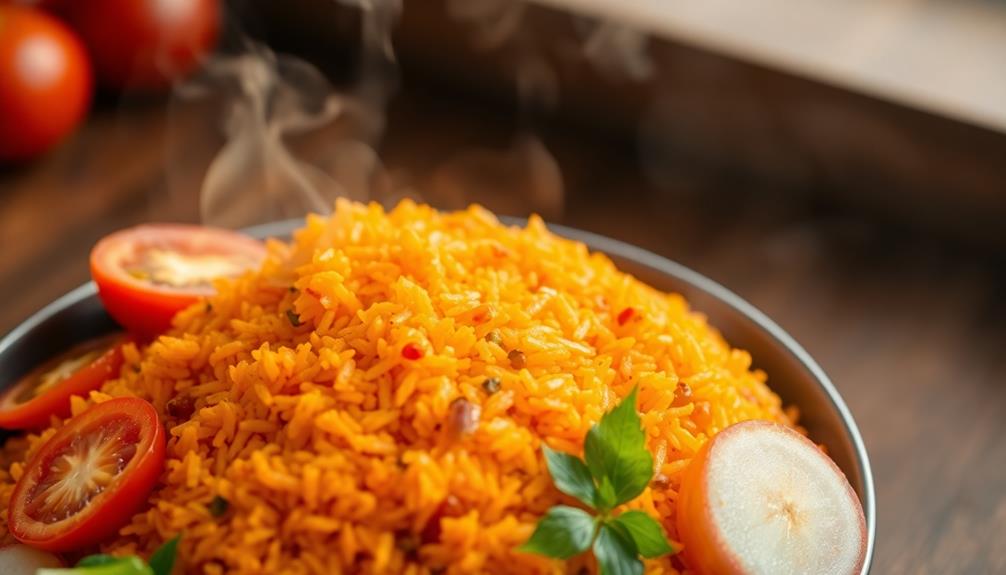
Jollof rice, the quintessential West African culinary treasure, has undoubtedly captured the hearts and palates of people around the globe. This vibrant and aromatic dish has become a source of cultural pride, sparking friendly debates among West Africans on the "one true" recipe.
But at the end of the day, Jollof is more than just a dish – it's a celebration of the rich diversity and shared traditions of the region.
Whether you prefer the smoky, tomato-based version from Ghana or the slightly sweeter rendition from Nigeria, Jollof rice has the power to bring people together, creating lasting memories and strengthening bonds.
So, embrace the delightful complexities of this iconic dish, and let its flavors transport you to the vibrant streets and bustling markets of West Africa.
Jollof rice isn't just a meal, but a culinary journey that celebrates the rich tapestry of African cuisine.
Frequently Asked Questions
What Is the Difference Between Jollof Rice and Jallof?
Jollof rice and jallof are two distinct West African dishes. Jollof rice is a one-pot rice dish, while jallof is a spicy stew-like meal made with rice, vegetables, and proteins. The key difference lies in their preparation and core ingredients.
Is Jallof a Vegetarian Dish or Does It Contain Meat?
Jallof is typically not a vegetarian dish, as it often contains meat like chicken or beef. While some versions may be made without meat, the traditional preparation usually includes some type of protein.
Can Jallof Be Made With Other Grains Besides Rice?
Absolutely, jallof can be made with other grains besides rice. You can use millet, fonio, or even quinoa to create delicious variations of this versatile West African dish.
How Long Does Jallof Take to Prepare and Cook?
Preparing and cooking jallof can take quite some time, usually around an hour or more. You'll need to soak the rice, blend the tomatoes and onions, and simmer the dish until the rice is tender and the flavors meld.
Is Jallof a Common Dish in All West African Countries?
Jallof isn't a common dish across all West African countries. It's predominantly found in certain regions, like Nigeria and Senegal, where it's considered a staple. The specific preparation and ingredients can vary between different countries and local traditions.
